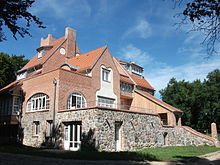Lietzenburg
The Lietzenburg is a listed Art Nouveau villa in the Kloster district on the island of Hiddensee , which the painter Oskar Kruse had built in 1904/1905.
Construction and use
Oskar Kruse (1847–1919), a merchant who had made some fortune in a timber trade and a painter since 1889, bought a 2.5- hectare property in Kloster in order to have a summer house built at its highest point. The Berlin architectural firm “Spalding & Grenander” emerged as the winner from a competition advertised by Kruse. Alfred Grenander designed the interior, Otto Spalding the architecture. The brick building has a basement made of local boulders . Above all, the interior is in Art Nouveau style.
The house has 15 living and working rooms and its own observation tower. Kruse named the property Lietzenburg based on his Berlin address ( Lietzenburger Straße ). He made his summer residence a popular meeting place with other artists and writers who came to appreciate the nature and seclusion of this small Baltic island. After the painter's death, his brother Max Kruse and his wife Käthe (doll maker) inherited the property. They continued the tradition that had started and had, among others, Max Reinhardt , Gerhart Hauptmann , Thomas Mann , but also scientists such as Albert Einstein and Gustav Hertz visiting. In the late 1920s, interest in the Kruse salons diminished: in the neighboring town of Vitte , a small artist colony of its own had developed around the Berlin painter Henni Lehmann .
Nothing is known about the Lietzenburg from 1933 to 1949, it is very likely that there were hardly any “artist meetings” and the Kruses spent their summer months here.
After 1949 the Lietzenburg came under state administration of the GDR , it served as a rest home for the Ernst Moritz Arndt University of Greifswald . In the neighborhood, new properties were built by artists such as Gret Palucca and Walter Felsenstein . The restaurant and guesthouse “Dünenhaus”, which was reserved for artists and users of the Lietzenburg, was available for short-term guest visits and catering.
After the end of the GDR, the Lietzenburg become the property of the son of Max and Käthe Kruse, the now well-known as a children's writer was Max Kruse transferred back. He did not use the building complex, but offered it for sale. After another change of ownership, the villa was renovated from 2009 to 2013 in accordance with a listed building. The work was directed by a Dresden architect. Six holiday apartments and a public area with a historic chimney hall and the Kruse Atelier, in which events have been taking place again since autumn 2013, were created.
literature
- Artist's country house with Kruse painter's studio on the island of Hiddensee near Rügen. In: Zentralblatt der Bauverwaltung , 23rd year 1903, No. 45 (from 6 June 1903), p. 279 f. (Reproduction on the private site http://www.u-bahn-archiv.de/geschichte/bio-grenander-1903-45_zdb.html )
- House Kruse on the island of Hiddensee. In: Moderne Baufformen , Volume 5, 1906, Issue 11 (from November 1906) ( online as a digitized version of the Heidelberg University Library), pp. 387–400.
- Ruth Negendanck : Hiddensee, the special island for artists. Verlag Atelier im Bauernhaus, Fischerhude 2005, ISBN 3-88132-288-4 , pp. 47–50.
- Ute Fritsch, Claus Beneking : The Lietzenburg on Hiddensee. Guest house with history. o. O., o. J. (Brochure, published by the owner of the villa, Beneking Lietzenburg GbR, available on site)
Web links
Footnotes
- ↑ Lietzenburg on Hiddensee has been renovated. In: Ostsee-Zeitung . July 1, 2013, archived from the original on July 3, 2013 ; accessed on September 1, 2014 (In August, the first holiday guests are expected in the striking building in Kloster .).
Coordinates: 54 ° 35 ′ 16.4 ″ N , 13 ° 6 ′ 13.5 ″ E

